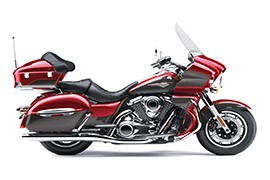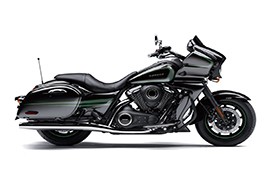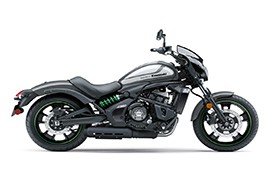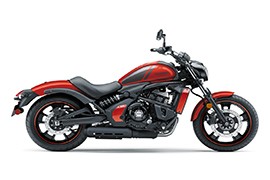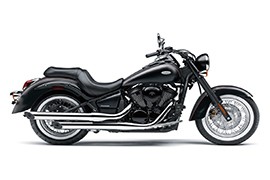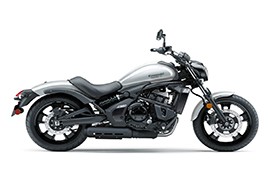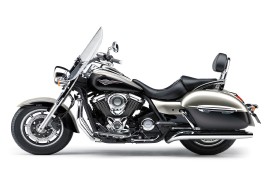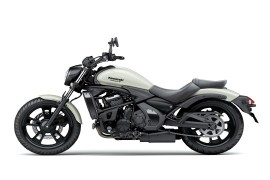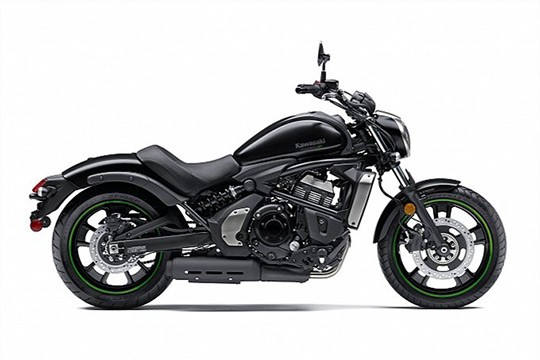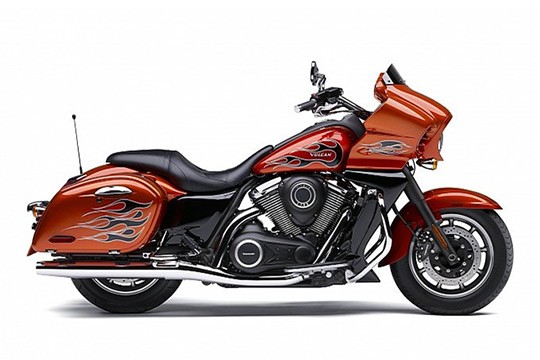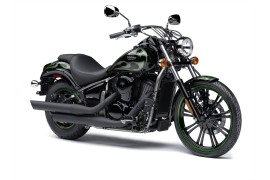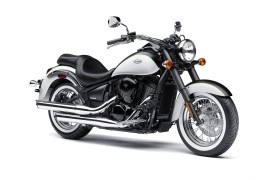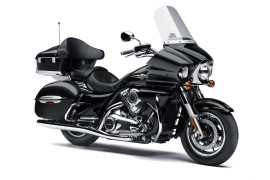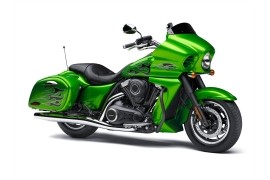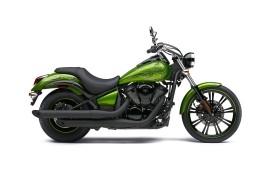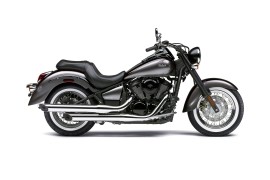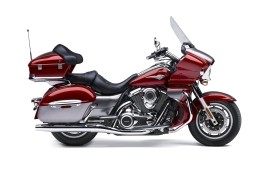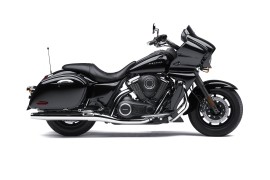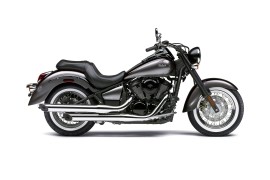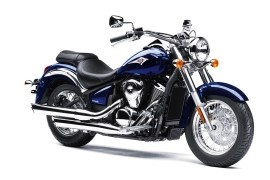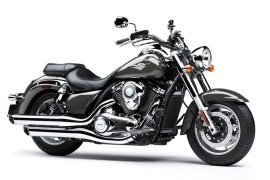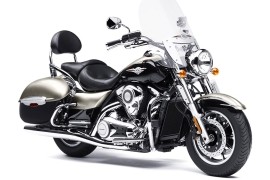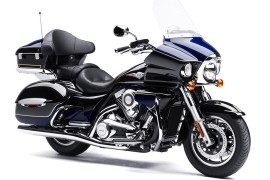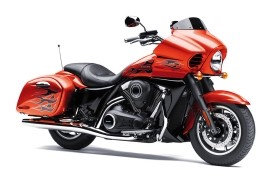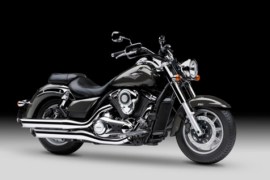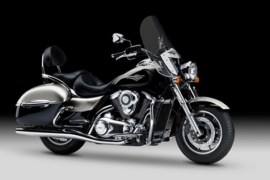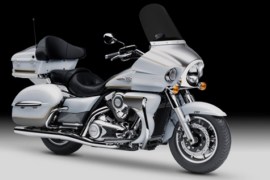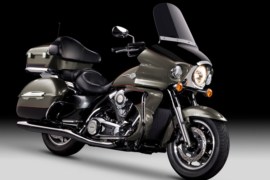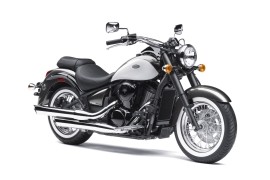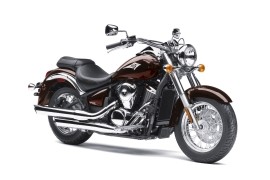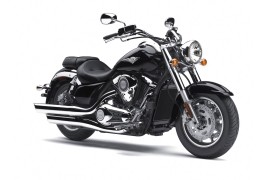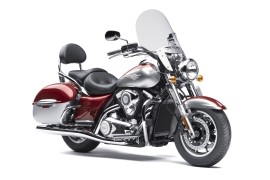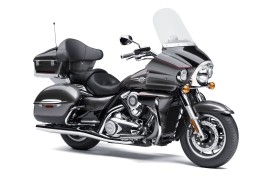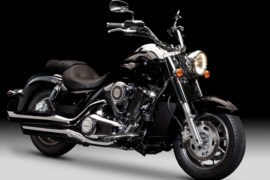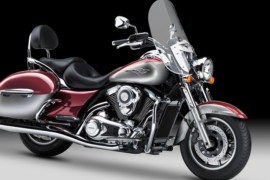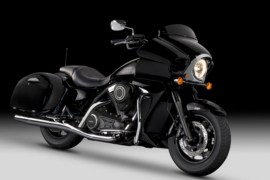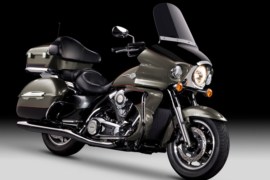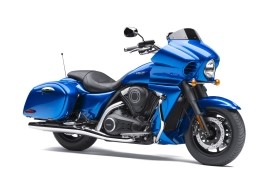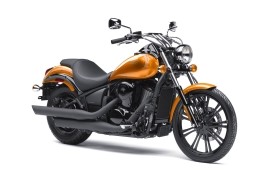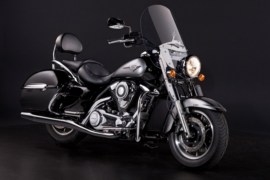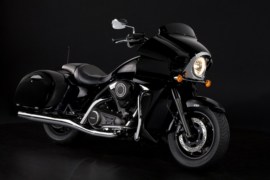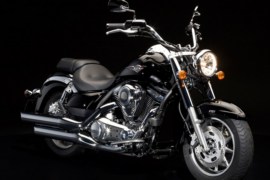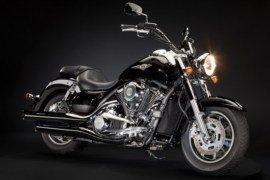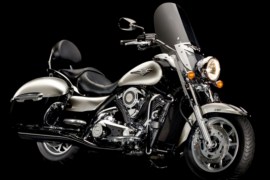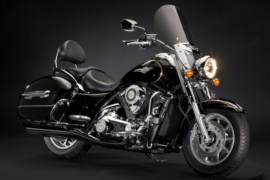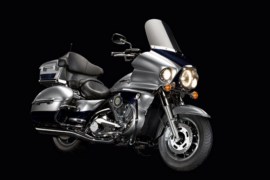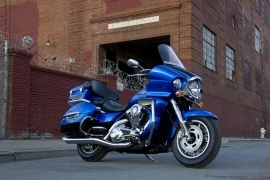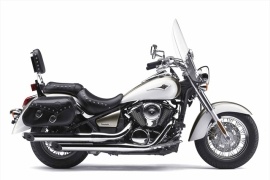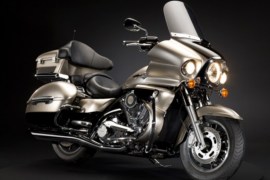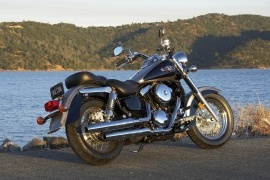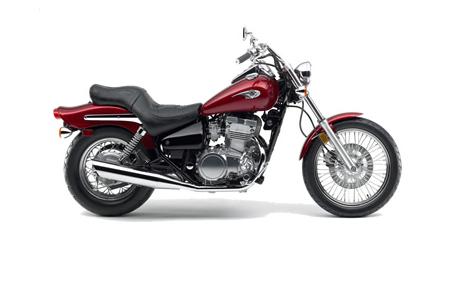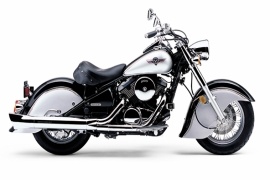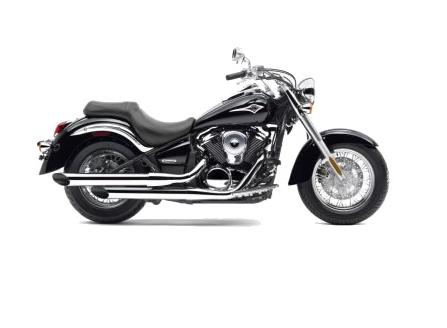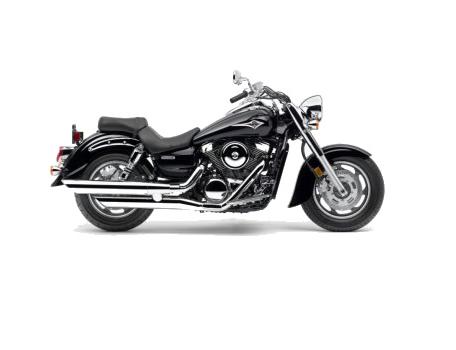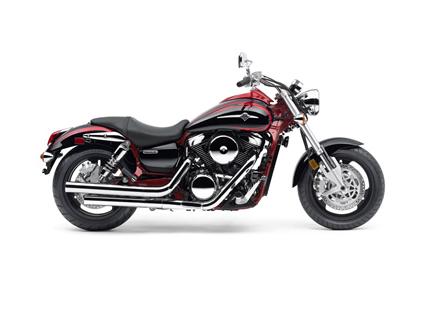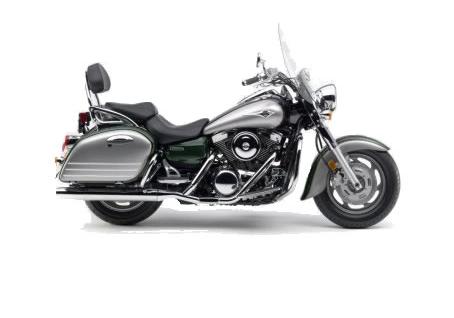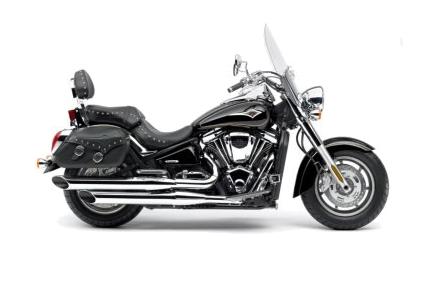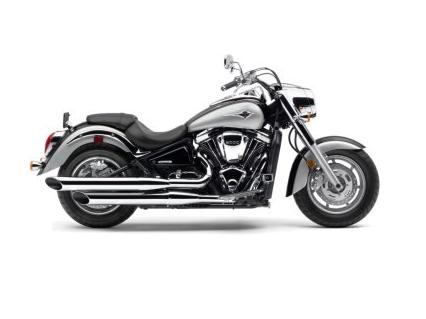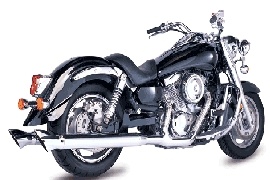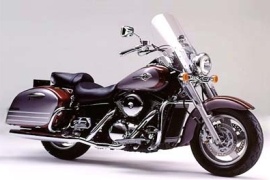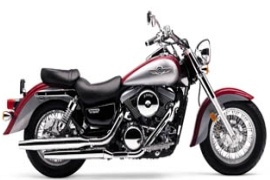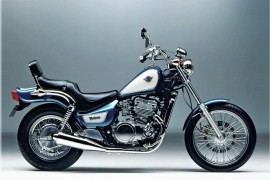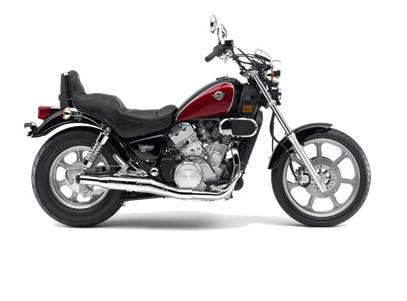KAWASAKI Vulcan Models/Series Timeline, Specifications & Photos
First production year: 1984
In 2018, the Japanese motorcycle manufacturer launched the Kawasaki Vulcan 1700 Voyager, a touring motorcycle designed for those riders who set their navigation system over the horizon line. The 2018 model was similar to previous models, packing the same appearance without any significant modifications except for color alterations.
The Kawasaki Vulcan 1700 Voyager debuted in 2009 alongside other versions, such as the Classic, Classic LT, Nomad, and Vaquero, that debuted in 2011. From 2009 until the present (2023), the Voyager featured minor technical, performance, and visual modifications.
The 2018 bike was equipped with standard features, such as a large front faring with a large windscreen for excellent wind protection, a comfortable two-piece dual seat, a top case with an integrated passenger backrest, color-matched side-mounted panniers, a dual exhaust system with a retro-look, and nine-spoke lightweight aluminum wheels.
Suspension-wise, the motorcycle packed a 43 mm telescopic fork with 140 mm wheel travel on the front and twin air-assisted four-way rebound-adjustable shock absorbers with 78 mm wheel travel on the rear, offering an excellent riding experience.
Besides its top-end electronics, the 2018 Kawasaki Vulcan 1700 Voyager had installed a 1,700cc four-stroke liquid-cooled V-twin engine underneath its fuel tank, managed by a fuel injection system, delivering 82 hp at 5,000 rpm and 146 Nm (107 lb-ft) torque at 2,750 rpm.
The Kawasaki Vulcan 1700 Vaquero was a cruiser motorcycle manufactured by Kawasaki in 2011. It was part of the Vulcan 1700 series that debuted in 2009, alongside the Classic, Classic LT, Nomad, and Voyager versions.
In 2018, the Japanese motorcycle manufacturer launched the Kawasaki Vulcan 1700 Vaquero ABS, a cruiser motorcycle based on the Voyager version. It featured many original-design components and was intended for those who were in search of modern comfort, plenty of technology, and Kawasaki dependability.
The 2018 model was similar in design to previous models, packing standard features, such as a large front fairing with a round headlight and a small visor, a teardrop-shaped fuel tank, a one-piece dual seat, side-mounted color-matched panniers, a dual exhaust system, and nine-spoke lightweight aluminum wheels.
The bike had an aggressive styling and was loaded with modern technology, such as Electronic Cruise Control, Advanced Coactive-Braking Technology (K-ACT) with ABS, a muscular V-twin engine, a full audio system, an open cruiser riding position, and many more.
In the performance department, the 2018 Kawasaki Vulcan 1700 Vaquero ABS had its soul brought to life by a 1,700cc four-stroke V-twin liquid-cooled engine fed by a digital fuel injection system, delivering 83 hp at 5,000 rpm and 146 Nm (108 lb-ft) torque at 2,750 rpm.
The braking performance was handled by two 300 mm discs with four-piston calipers on the front wheel and a 300 mm disc tied to a dual-piston caliper on the rear wheel, offering excellent stopping power.
The Kawasaki Vulcan S was a cruiser motorcycle that debuted in 2015. It was part of the Vulcan series that debuted in 1984 with the Kawasaki VN700A as their first cruiser motorcycle powered by their first V-twin engine.
The bike featured the engine and instruments of the Kawasaki ER-6. In addition, the engine was modified by receiving a 30 percent larger flywheel and different camshafts and being limited to only 10,000 rpm.
In 2018, the Japanese motorcycle manufacturer launched the Kawasaki S ABS Cafe, a cruiser motorcycle with a three-tone paint scheme, tank badging, and sports stripes that emphasized the sportiness of the Vulcan S.
In the visual department, the machine has been equipped with standard features, such as a single headlight unit, a wind deflector for better protection, a teardrop-styled fuel tank, a single seat with the possibility of adding a passenger seat, an under-belly exhaust system, and five-spoke aluminum wheels.
The bike's skeleton was a high tensile diamond steel frame with a 41 mm telescopic fork on the front and an offset lay-down preload-adjustable shock absorber on the rear, delivering excellent suspension performance and handling.
In the performance department, the 2018 Kawasaki Vulcan S ABS Cafe had its heartbeat set by a 649cc four-stroke liquid-cooled parallel-twin engine with a fuel injection system in charge, boasting 61 hp at 7,500 rpm and 63 Nm (47 lb-ft) torque at 6,600 rpm.
In 2018, the Japanese motorcycle manufacturer launched the Kawasaki Vulcan S ABS SE, a cruiser motorcycle with Kawasaki Ergo-fit components that enhanced its versatility and accommodated riders of different shapes and sizes.
The Kawasaki Vulcan S debuted in 2015 and was part of the Vulcan series that debuted in 1984 with the VN700A as their first cruiser motorcycle powered by their first V-twin engine.
In the visual department, the bike had standard features, such as a single headlight unit up front, a wide handlebar, a single seat with a low riding position, an under-belly-mounted exhaust system, and lightweight five double-spoke wheels.
The bike was built around a high tensile diamond steel frame with a 41 mm telescopic fork on the front, offering 129 mm of travel, and an offset lay-down preload adjustable shock absorber on the rear, offering 81 mm of travel.
The bike's wheels were fitted with a 300 mm brake disc coupled to a dual-piston caliper on the front and a 25 mm disc with a single-piston caliper on the rear, delivering excellent stopping power enhanced by an Anti-Lock Braking System (ABS).
The 2018 Kawasaki Vulcan S ABS SE had its soul brought to life by a 649cc four-stroke parallel-twin liquid-cooled engine managed by an electronically controlled fuel injection system. As for the power figures, the engine delivered 61 hp at 7,500 rpm and 63 Nm (47 lb-ft) torque at 6,600 rpm.
In 2017, the Japanese motorcycle manufacturer launched the Kawasaki Vulcan 900 Classic, a mid-sized cruiser motorcycle with a low seat height, the largest rear tire, and the largest fuel tank capacity in its class.
The bike debuted in 2006 as a boulevard-styled cruiser similar to the Harley-Davidson Softail Deluxe or the Fat Boy and followed the same recipe of using a smaller engine in a slightly larger chassis like Honda, Suzuki, and Yamaha in their cruiser lines.
In the visual department, the 2017 motorcycle had standard features, such as a wide pulled-back handlebar, a teardrop-shaped fuel tank, a one-piece dual seat, forward-mounted floorboards, a blacked-out engine, a dual chromed exhaust system, and wire-spoke wheels with white-wall tires.
Suspension-wise, the bike was built around a semi-double cradle high tensile steel frame with a 41 mm telescopic fork on the front and a seven-position preload-adjustable uni-trak shock absorber on the rear, offering optimum suspension performance and handling capabilities.
As for the power figures, the 2017 Kawasaki Vulcan 900 Classic had its heartbeat set by a 903cc four-stroke V-twin liquid-cooled engine fed by an electronically controlled fuel injection system, delivering 50 hp at 5,700 rpm and 79 Nm (59 lb-ft) torque at 3,500 rpm.
The power produced by the engine was transferred to a five-speed manual transmission with a wet multi-plate clutch and sent to the rear wheel through a low-maintenance final Kevlar-reinforced belt drive.
The Kawasaki Vulcan S was a cruiser-styled motorcycle made by Kawasaki since 2015. The bike was part of the Vulcan series that debuted in 1984 with the VN700A as their first cruiser motorcycle powered by their first V-twin engine.
The bike borrowed some elements from the Kawasaki ER-6, like the engine and instruments. The engine was modified with a 30 percent larger flywheel and different camshafts and was limited to 10,000 rpm.
In 2017, the Japanese motorcycle manufacturer launched the Kawasaki Vulcan S ABS, a cruiser machine featuring the same appearance and performance specifications as previous models and fitted with a safety package in the form of an Anti-Lock Braking System (ABS), enhancing its handling and offering a safer riding experience.
In the performance department, the 2017 Kawasaki Vulcan S ABS had its soul brought to life by a 649cc four-stroke parallel-twin liquid-cooled engine fed by a fuel injection system, delivering an output power of 61 hp at 7,500 rpm and 63 Nm (47 lb-ft) torque at 6,600 rpm.
The power produced by the engine was transferred to a six-speed manual transmission with a wet multi-disc clutch and sent to the rear wheel through a final sealed chain drive.
The motorcycle was manufactured around a perimeter high tensile steel frame with a 41 mm telescopic fork on the front and an offset lay-down preload-adjustable shock absorber on the rear, delivering excellent suspension performance and handling.
In 2016, the Japanese motorcycle manufacturer launched the Kawasaki Vulcan 1700 Nomad, a cruiser motorcycle that debuted in 2011. The bike was part of the Vulcan 1700 series alongside the Classic, Classic LT, Voyager, and Vaquero versions.
The Kawasaki Vulcan was a series of touring motorcycles manufactured by Kawasaki since 1984. The bikes were powered primarily by V-twin engines with displacements ranging from 125 to 2,053cc.
The Vulcan 1700 Nomad combined the retro look of a classic American motorcycle and the functionality of a big touring machine with Kawasaki's dependability. It packed several touring accessories that made long hauls more comfortable.
The bike had standard features, such as a round headlight with a chromed housing, a teardrop-styled tank, a two-piece dual seat, a dual exhaust system with a silencer on each side, and nine-spoke lightweight aluminum wheels.
In addition to its standard features, the Nomad version packed a large windscreen for better wind and debris protection, a passenger backrest for a more comfortable riding experience, and side-mounted color-matched panniers for extra storage.
In the performance department, the 2016 Kawasaki Vulcan 1700 Nomad had installed a 1,700cc four-stroke V-twin liquid-cooled engine underneath its fuel tank, fed by an electronically controlled fuel injection system.
As for the power figures, the engine delivered an output power of 73 hp at 5,000 rpm and 136 Nm (100 lb-ft) torque at 2,750 rpm. The 2016 Kawasaki Vulcan 1700 Nomad had an MSRP starting at $16,500.
In 2016, the Japanese motorcycle manufacturer launched the Kawasaki Vulcan S, a cruiser motorcycle in its second year of production. It featured the same technical, visual, and performance specifications as the previous model without any modifications except for color alterations.
The Vulcan S was a cruiser motorcycle manufactured by Kawasaki since 2015, part of the Vulcan series that debuted in 1984 with the VN700A as their first cruiser motorcycle powered by their first V-twin engine.
In addition to the base model, the maker released two other models, including the Vulcan S ABS SE, available in an Imperial Blue with a Metallic Spark Black two-tone color scheme, and the Vulcan S ABS Cafe, which featured a tinted wind deflector and a Metalic Matte Carbon Grey with a Lime Green sports stripe down its entire length.
The 2015 S model had standard features, such as a single headlight unit up front, a wide handlebar, a single seat with a low riding position, an under-belly-mounted exhaust system, and lightweight five double-spoke wheels.
Underneath its fuel tank, the 2015 Kawasaki Vulcan S had installed a 649cc four-stroke parallel-twin liquid-cooled engine with a fuel injection system in charge, boasting 61 hp at 7,500 rpm and 62 Nm (46 lb-ft) torque at 6,600 rpm.
The braking power was achieved by a 300 mm disc coupled to a dual-piston caliper on the front wheel and a 250 mm disc with a single-piston caliper on the rear wheel, offering excellent stopping power.
The Kawasaki Vulcan S was a cruiser motorcycle manufactured by Kawasaki since 2015. The bike was part of the Vulcan series that debuted in 1984 with the VN700A as their first cruiser motorcycle powered by their first V-twin engine.
The bike's engine and instruments were borrowed from the Kawasaki ER-6, while the engine was modified and packed a 30 percent larger flywheel and different camshafts, being limited to 10,000 rpm.
The 2015 motorcycle had standard features, such as a single headlight unit up front, a wide handlebar, a single seat with a low riding position, an under-belly-mounted exhaust system, and lightweight five double-spoke wheels.
The bike was built around a perimeter high tensile steel frame with a 41 mm telescopic fork on the front and an offset lay-down preload-adjustable shock absorber on the rear, delivering excellent suspension performance and handling.
In the braking department, the bike packed a 300 mm disc coupled to a dual-piston caliper on the front wheel and a 250 mm disc with a single-piston caliper on the rear wheel, offering excellent stopping power enhanced by an Anti-Lock Braking System (ABS).
As for performance, the 2015 Kawasaki Vulcan S ABS had installed a 649cc four-stroke parallel-twin liquid-cooled engine underneath its fuel tank, delivering 61 hp with a peak force at 7,500 rpm and 63 Nm (47 lb-ft) torque at 6,600 rpm.
The Kawasaki Vulcan 1700 Vaquero was a cruiser motorcycle that debuted in 2011 and was part of the Vulcan 1700 series alongside the Classic, Classic LT, Nomad, and Voyager versions that debuted in 2009 and continued production until the present (2023).
In 2014, the Japanese motorcycle manufacturer launched the Kawasaki Vulcan 1700 Vaquero SE ABS, a special edition model available for purchase only in the American market.
The special edition model packed the exact technical and performance specifications as the 2014 base model but with an additional new Candy Burnt Orange color scheme complemented by black flame vinyl on the panniers, fuel tank, and front cowl, matching the blacked-out accents of the engine and chassis.
Besides that, the bike packed the same standard features as the base model, including a large front cowl with a small windscreen, a teardrop-styled tank, a one-piece dual seat, side-mounted color-matched panniers, a dual exhaust system with a silencer on each side, and nine-spoke lightweight aluminum wheels.
The bike's wheels were fitted with two 300 mm discs coupled to four-four-piston calipers on the front and a 300 mm disc with a dual-piston caliper on the rear, offering excellent stopping power enhanced by an Anti-Lock Braking System (ABS).
As for power, the 2014 Kawasaki Vulcan 1700 Vaquero SE ABS had installed a 1,700cc four-stroke liquid-cooled V-twin engine underneath its fuel tank, delivering an output power of 83 hp at 5,000 rpm and 146 Nm (108 lb-ft) torque at 2,750 rpm.
In 2014, the Japanese motorcycle manufacturer launched the Kawasaki Vulcan 900 Custom, a cruiser motorcycle that debuted in 2009 alongside the Classic and Classic LT versions. The 2014 motorcycle was available at an MSRP of $8,500.
The bike was in its sixth year of production and came with the same package as previous models, featuring the exact visual, technical, and performance specifications without any modifications, except for color alterations.
The bike packed standard features, such as a round headlight up front, a wide, pulled-back handlebar, a teardrop-styled fuel tank, a one-piece dual seat, a blacked-out dual slash-cut exhaust system, and black-finished aluminum wheels.
Suspension-wise, the motorcycle was built on a double cradle high tensile steel frame with a 41 mm telescopic fork on the front, offering 150 mm of travel, and a seven-way preload-adjustable uni-trak shock on the rear that offered 103 mm of travel.
In the braking department, the bike's wheels were stopped by a 300 mm disc with a dual-piston caliper on the front and a 270 mm disc with a two-piston caliper on the rear, offering the best braking performance in its class.
As for the power figures, the 2014 Kawasaki Vulcan 900 Custom had installed a 903cc four-stroke liquid-cooled V-twin engine underneath its fuel tank, delivering an output power of 50 hp with a peak force at 5,700 rpm and 106 Nm 978 lb-ft) torque at 3,500 rpm.
The Kawasaki Vulcan was a series of custom or touring motorcycles that debuted in 1984 with the VN designation and powered mainly by V-twin engines with displacements ranging from 125 to 2,053cc.
In 2006, the Japanese maker introduced the Kawasaki Vulcan 900 Classic, a mid-sized cruiser motorcycle that followed the same recipe of using a smaller engine in a one-size larger chassis like Yamaha, Suzuki, and Honda.
In 2014, the maker introduced the Kawasaki Vulcan 900 Classic, a cruiser motorcycle similar to the first 2006 model without any significant modifications, except for color alteration and minor aesthetic and ergonomic changes.
The 2014 machine had standard features, such as a large round headlight, a wide handlebar, a one-piece redesigned dual seat with lumbar support for the rider and a wider and longer seating area for the passenger, a dual slash-cut chromed exhaust system, and wire-spoke wheels with white-wall tires.
In the performance department, the 2014 Kawasaki Vulcan 900 Classic had its soul brought to life by a 903cc four-stroke V-twin liquid-cooled engine fed by a fuel injection system, delivering 50 hp at 5,700 rpm and 79 Nm (58 lb-ft) torque at 3,700 rpm.
Suspension-wise, the bike packed a 41 mm telescopic fork on the front with 150 mm of travel and a uni-trak seven-way preload-adjustable shock absorber with 103 mm of travel on the rear, offering optimum suspension performance and handling.
The Kawasaki Vulcan was a series of touring or custom motorcycles manufactured by Kawasaki from 1984. The bikes also used the "VN" designation and were powered mainly by V-twin engines with displacements ranging between 125 to 2,053cc.
In 2014, the Japanese motorcycle launched the Kawasaki Vulcan 1700 Voyager ABS, a touring bike designed for those riders who planned their journeys beyond the horizon line. The bike was available with ABS, which enhanced its handling capabilities and offered a safer riding experience.
In the visual department, the 2014 model packed the same standard features as the previous model, including a sizeable frame-mounted front fairing with a large headlight on the center, two smaller ones on each side, and a large windscreen that offered excellent wind protection.
It offered a comfortable two-piece dual seat with a large top case that could fit two full-face helmets and an integrated passenger backrest for more comfort. On each side, the bike had a large, color-matched pannier for extra storage.
The bike's engine exhaled through a chromed dual exhaust system with a long silencer on each side and rolled on nine-spoke lightweight wheels. In addition, the large touring machine was fitted with top-end electronics to make the riding more comfortable and safer.
As for the power figures, the 2014 Kawasaki Vulcan 1700 Voyager ABS had its soul brought to life by a 1,700cc four-stroke V-twin liquid-cooled engine that delivered an output power of 73 hp at 5,000 rpm and 136 Nm (100 lb-ft) torque at 2,750 rpm.
In 2014, the Japanese motorcycle manufacturer launched the Kawasaki Vulcan 1700 Vaquero ABS, a cruiser motorcycle that debuted in 2011. The bike was part of the Vulcan 1700 series that debuted in 2009 and continued production until the present (2023).
The Vulcan series was introduced in 1984 with the VN700A as their first cruiser motorcycle powered by their first V-twin engine. The bikes were designated as "VN" and were primarily powered by V-twin engines with displacements ranging from 125 to 2,053.
The 2014 motorcycle packed standard features, such as a large front cowl with a small visor, a round headlight, a teardrop-styled tank, a one-piece dual seat, color-matched side-mounted panniers, a dual exhaust system with a silencer on each side, and lightweight nine-spoke aluminum wheels.
The wheels were fitted with two 300 mm discs coupled to dual-piston calipers on the front and a 300 mm disc tied to a two-piston caliper, delivering excellent stopping power enhanced by a standard Anti-Lock Braking System (ABS).
As for the power figures, the 2014 Kawasaki Vulcan 1700 Vaquero ABS had installed a 1,700cc four-stroke V-twin liquid-cooled engine managed by an electronically controlled fuel injection system, delivering 83 hp at 5,000 rpm and 146 Nm (108 lb-ft) torque at 2,750 rpm.
The power produced by the engine was transferred to a six-speed manual transmission with a wet multi-disc clutch and sent to the rear wheel through a low-maintenance final carbon fiber belt drive.
The Vulcan series was brought to life by the Japanese motorcycle manufacturer Kawasaki in 1984. It was a custom or touring series that comprised several motorcycles with the "VN" designation and powered mainly by V-twin engines with displacement ranging from 125 to 2,053cc.
Since its introduction, Kawasaki released several series with different engine displacements, including the 900 series that debuted in 2006 and continued production until the present (2023), comprising three versions: the Kawasaki Classic, Classic LT, and Custom.
The 900 Classic was the base version, while the Classic LT featured a large windscreen, saddlebags, a passenger backrest, and studded accents. The Custom version was the same as the Classic but with a wide 180 mm rear tire, a 21-inch thin front wheel, a smaller and lower-profile seat, and a drag-styled handlebar.
In 2013, the Japanese motorcycle manufacturer launched the Kawasaki Vulcan 900 Custom, a cruiser motorcycle with standard features, such as a round headlight up front, a teardrop-shaped fuel tank, a one-piece dual seat, a dual slash-cut exhaust system, and aluminum wheels.
The 2013 Kawasaki Vulcan 900 Custom had its heartbeat set by a 903cc four-stroke V-twin liquid-cooled engine managed by an electronically controlled fuel injection system, boasting 50 hp with maximum strength at 5,700 rpm and 106 Nm (78 lb-ft) torque at 3,500 rpm.
In 2013, the Japanese motorcycle manufacturer launched the Kawasaki Vulcan 900 Classic, a mid-sized cruiser motorcycle part of the Vulcan series in Kawasaki's range that debuted in 1984. The range comprised several models powered mainly by V-twin engines with displacement ranging from 125 to 2,053cc.
The 2013 Vulcan 900 Classic was in its eighth year of production and packed the same technical, performance, and visual specifications as previous models without any significant modifications, except for minor aesthetic and color changes.
The bike had standard features, such as a round headlight upfront, a wide pulled-back handlebar, a teardrop-shaped fuel tank with an integrated instrument panel, a one-piece dual seat, a dual chromed slash-cut exhaust system, and wire-spoke wheels.
In the performance department, the 2013 Kawasaki Vulcan 900 Classic had its heartbeat set by a 903cc four-stroke liquid-cooled V-twin engine managed by a fuel injection system, delivering 50 hp with a peak force at 5,700 rpm and 79 Nm (58 lb-ft) torque at 3,700 rpm.
The power produced by the engine was transferred to a five-speed manual transmission with a wet multi-plate clutch and sent to the rear wheel through a low-maintenance final Kevlar belt drive.
The bike was built around a double cradle high tensile steel frame with a 41 mm telescopic fork and a 300 mm disc with a dual-piston caliper on the front, handling the bike's suspension and braking performance. The rear end was driven by a seven-position adjustable uni-trak shock absorber and a 270 mm disc with a dual-piston caliper.
The Kawasaki Vulcan was a series of custom or touring motorcycles manufactured by Kawasaki since 1984. The bikes were powered mainly by V-twin engines with displacements ranging from 125 to 2,053cc.
The range comprised several series with different engine displacements and appearances, like the Vulcan 1700 Series, which included the Classic, Classic LT, Voyager, Vaquero, and Nomad versions.
The Kawasaki Vulcan 1700 Nomad debuted in 2011 and was a combination between the retro look of a classic American motorcycle and the functionality of a big cruiser machine with Kawasaki's dependability.
In 2013, the Japanese motorcycle manufacturer launched the Kawasaki Vulcan 1700 Nomad ABS, a cruiser motorcycle that packed the same specifications as the 2013 base model, including an additional safety feature in the form of an Anti-Lock Braking System (ABS).
The bike had standard features, such as a round headlight with a chromed housing, a large windscreen, a teardrop-shaped fuel tank, a two-piece dual seat with a passenger backrest, side-mounted color-matched panniers, and nine-spoke aluminum wheels.
The 2013 Kawasaki Vulcan 1700 Nomad ABS had installed a 1,700cc four-stroke liquid-cooled V-twin engine between its wheels, fed by a fuel injection system, delivering an output power of 73 hp with a peak force at 5,000 rpm and 136 Nm (100 lb-ft) torque at 2,750 rpm.
In 2013, the Japanese motorcycle manufacturer launched the Kawasaki Vulcan 1700 Voyager ABS, a touring motorcycle especially designed for long hauls, packing several touring accessories for protection and comfort.
In addition, the 2013 Voyager came with an extra safety feature in the form of an Anti-Lock Braking System, offering more peace of mind, better controllability on different surfaces, and shorter stopping distances.
The bike was equipped with standard features, such as a large frame-mounted front fairing, a large windscreen for better wind protection, a two-piece dual seat with a large top case and an integrated passenger backrest for more comfort, side-mounted panniers for extra storage, a dual chromed exhaust system, and nine-spoke lightweight aluminum wheels.
The bike was manufactured around a double cradle high tensile steel frame with a 43 mm telescopic fork on the front, offering 140 mm of travel and two air-assisted four-position rebound-adjustable shocks on the rear, providing 78 mm wheel travel.
The 2013 Kawasaki Vulcan 1700 Voyager had installed a 1,700cc four-stroke liquid-cooled V-twin engine underneath its fuel tank, managed by a fuel injection system, boasting 73 hp at 5,000 rpm and 136 Nm (100 lb-ft) torque at 2,750 rpm.
The bike's power was transferred to a five-speed manual transmission with a wet multi-disc clutch and sent to the rear wheel through a low-maintenance final carbon fiber belt drive.
In 2013, the Japanese motorcycle manufacturer launched the Kawasaki Vulcan 1700 Vaquero ABS, a cruiser motorcycle that debuted in 2011 alongside the Classic, Classic LT, Nomad, and Voyager versions part of the same series.
The 2013 motorcycle packed the same performance and visual specifications as the previous model but with a blacked-out appearance and a new safety feature in the form of an Anti-Lock Braking System (ABS) that delivered better handling and a safer riding experience.
In the aesthetic department, the bike packed blacked-out standard features, such as a large front fairing with a small windscreen, a teardrop-shaped fuel tank, a one-piece dual seat, color-matched side-mounted panniers, engine, fenders, wheels, and a dual chromed exhaust system.
The bike was built around a double cradle high tensile steel frame, packing a 45 mm telescopic fork on the front with 140 mm of travel and twin air-assisted four-way rebound-adjustable shocks on the rear with 80 mm wheel travel.
As for the braking performance, the new ABS worked in tandem with two 300 mm discs tied to dual-piston calipers on the front wheel and a 300 mm disc with a two-piston caliper on the rear wheel, offering excellent stopping power and a shorter braking distance.
The 2013 Kawasaki Vulcan 1700 Vaquero ABS had its heartbeat set by a 1,700cc four-stroke liquid-cooled V-twin engine managed by a fuel injection system, boasting 83 hp at 5,000 rpm and 146 Nm (108 lb-ft) torque at 2,750 rpm.
In 2013, the Japanese motorcycle manufacturer launched the Kawasaki Vulcan Custom SE, a special edition motorcycle that packed the same technical and performance specifications as the base model but with more modern and aggressive colors and accents that enhanced its overall appearance.
The Kawasaki Vulcan Custom was part of the Vulcan 900 series that debuted in 2006. The range comprised the Custom, Classic, and Classic LT versions that featured similar appearances with different accessories and elements.
The bike combined the classic and modern worlds, packing standard features, such as a round headlight on the front, a wide-pulled-back handlebar, a teardrop-shaped fuel tank, a one-piece dual seat, a black-out dual exhaust system, a slim nine-spoke aluminum wheel on the front, and a wide 180 mm tire on the rear.
Like other Vulcan models, the bike was built around a double cradle high tensile steel frame with a 41 mm telescopic fork on the front and a uni-trak seven-way preload-adjustable shock absorber on the rear, offering optimum suspension performance and handling.
As for the power figures, the 2013 Kawasaki Vulcan 900 Custom SE had installed a 903cc four-stroke V-twin liquid-cooled engine underneath its fuel tank, fed by an electronically controlled fuel injection system, delivering 50 hp at 5,700 rpm and 79 Nm (58 lb-ft) torque at 3,500 rpm.
The engine worked in tandem with a five-speed manual transmission and a wet multi-disc clutch that sent the power to the rear wheel through a low-maintenance final Kevlar belt drive.
The Kawasaki Vulcan 900 Classic was a mid-sized cruiser motorcycle that debuted in 2006, part of the Vulcan series that comprised several models with different engine displacements ranging from 125 to 2,053cc.
In the visual department, the Vulcan 900 Classic had a boulevard style like the Harley-Davidson Softail Deluxe or the Fat Boy and followed the same recipe as Honda, Suzuki, and Yamaha by fitting a smaller engine in a slightly larger chassis.
The bike packed standard features, such as a round headlight with a chrome housing, a wide handlebar, a teardrop-styled tank, a two-piece dual seat, a dual chromed exhaust system mounted on the right side, and lightweight wire-spoke wheels.
The bike was built around a double cradle high tensile steel frame with a 41 mm telescopic fork on the front and a uni-trak seven-position spring preload-adjustable shock absorber on the rear, offering optimum handling capabilities.
Braking-wise, the 2012 motorcycle packed a 300 mm disc with a dual-piston caliper on the front wheel and a 270 mm disc with a dual-piston caliper on the rear wheel, offering optimum braking performance.
As for power, the 2012 Kawasaki Vulcan 900 Classic had installed a 903cc four-stroke V-twin liquid-cooled engine underneath its fuel tank, fed by an electronically controlled fuel injection system, delivering 50 hp with maximum strength at 5,700 rpm and 79 Nm (58 lb-ft) torque at 3,700 rpm.
The 2013 MY Kawasaki Vulcan 1700 Classic has been designed with the same retro look of a typical American motorcycle, born and bread for the open road. A brawny V-twin with a displacement of 1700cc breathes out through dual staggered mufflers with a powerful and rich sound. And they also look good, adding a dash of custom DNA to the build.
For more comfort and better handling, the Vulcan has been designed with 9-spoke cast wheels, which allow the use of tubeless tires to complement the chassis' excellent handling capabilities, as long as you stick to asphalt.
The bodywork has been a primary concern for Kawasaki in this model. The fuel tank has hand-sculpted contours to add to the overall beauty of the motorcycle and the taillights are LED, which help both with the visual aspect and the financial one.
The Kawasaki Vulcan was a series of touring or custom motorcycles manufactured by Kawasaki since 1984. The bikes had the "VN" designation and were powered mainly by V-twin engines with displacements ranging from 125 to 2,053cc.
The Vulcan range comprised several motorcycles with different displacement engines and appearances, like the Vulcan 1700 series that debuted in 2009 with the Classic, Classic LT, Nomad, and Voyager versions. Also, from 2011, the range was complemented by the Vaquero version.
In 2012, the Japanese motorcycle manufacturer released the Kawasaki Vulcan 1700 Nomad, a touring motorcycle part of the Vulcan 1700 series that perfectly combined the Classic American motorcycle appearance with the versatility and comfort of a touring motorcycle.
The 2012 motorcycle packed the same standard features as the previous model, such as a large windscreen for better wind protection, a teardrop-shaped fuel tang with an integrated instrument panel, a comfortable two-piece dual seat with a passenger backrest for more comfort, side-mounted panniers, a dual exhaust system, and nine-spoke aluminum wheels.
The 2012 Kawasaki Vulcan 1700 Nomad had its heartbeat set by a 1,700cc four-stroke liquid-cooled V-twin engine with a fuel injection system in charge, boasting 73 hp with a peak force at 5,000 rpm and 136 Nm (100 lb-ft) torque at 2,750 rpm.
The power produced by the engine was converted into motion by a six-speed manual transmission with a wet multi-disc clutch and sent to the rear wheel through a low-maintenance final carbon fiber belt drive.
In 2012, the Japanese motorcycle manufacturer launched the Kawasaki Vulcan 1700 Voyager, a touring motorcycle that debuted in 2009. The 2012 model packed the same technical, visual, and performance specifications as the previous one without significant modifications.
The Kawasaki Vulcan was a range of custom or touring motorcycles manufactured by Kawasaki since 1984. The bikes were also known with a VN designation and were powered mainly by V-twin engines with displacements ranging between 125 to 2,053cc.
The bike came equipped with standard features, such as a large frame-mounted front fairing, a large windscreen for better wind protection, a two-piece dual seat with a large top case with an integrated passenger backrest for more comfort, side-mounted hard panniers for extra storage, a dual chromed exhaust system, and nine-spoke lightweight aluminum wheels.
The latest modification was on the 2011 model. It included a quieter shifting action due to some alterations inside the gearbox, redesigned silencers that improved the sound quality and had a more classic look, and an improved fuel injection system that matched the new silencers more accurately.
In the performance department, the 2012 Kawasaki Vulcan 1700 Voyager had its heartbeat set by a 1,700cc four-stroke V-twin liquid-cooled engine, with a fuel injection system in charge, delivering an output power of 73 hp at 5,000 rpm and 136 Nm (100 lb-ft) torque at 2,750 rpm.
In 2012, the Japanese motorcycle manufacturer launched the Kawasaki Vulcan 1700 Vaquero, a custom cruiser motorcycle manufactured by Kawasaki from 2011. The bike was in its second year of production and packed the same specifications as the previous model without any modifications except for color alterations.
The motorcycle had standard features, such as a large front fairing on the front with a large round headlight, a small windscreen, a one-piece dual seat, side-mounted color-matched panniers, a black-finished engine breathing through a dual chromed exhaust system, and nine-spoke lightweight aluminum wheels.
Like other Vulcan models, the Vaquero version was built around a double cradle high tensile steel frame with a 45 mm telescopic fork on the front, delivering 140 mm of travel and two air-assisted four-way rebound-adjustable shock absorbers on the rear, offering 80 mm of travel.
The braking performance was handled by a 300 mm disc with a dual-piston caliper on the front wheel and a 300 mm disc with a two-piston caliper on the rear wheel, offering excellent stopping power.
The 2012 Kawasaki Vulcan 1700 Vaquero had installed a 1,700cc four-stroke V-twin liquid-cooled engine underneath its fuel tank, managed by an electronically controlled fuel injection system. As for the power figures, the engine boasted 83 hp with a peak force at 5,000 rpm and 146 Nm (108 lb-ft) torque at 2,750 rpm.
In 2012, the Japanese motorcycle manufacturer launched the Kawasaki VN1700 Classic, a cruising motorcycle that debuted in 2009 and packed the same visual, technical, and performance specifications as the previous model without any modifications.
The Kawasaki Vulcan was a series of custom or touring motorcycles that debuted in 1984 with the VN700A as their first cruiser machine powered by their first V-twin engine. The models used the "VN" designation and were mainly powered by V-twin engines with displacement ranging from 125 to 2,053cc.
The 2012 Classic version was the base model, while other versions were available, including the Classic LT, Nomad, Voyager, and Vaquero. The bikes were differentiated by accessories and appearances.
The 2012 motorcycle had standard features, such as a round headlight with a chromed housing up front, a pulled-back handlebar, a teardrop-shaped fuel tank, a two-piece dual seat, a dual chromed exhaust system, and nine-spoke lightweight alloy wheels.
In the performance department, the 2012 Kawasaki VN1700 Classic had its soul brought to life by a 1,700cc four-stroke liquid-cooled V-twin engine fed by a fuel injection system, boasting 74 hp with a peak force at 5,000 rpm and 136 Nm (100 lb-ft) torque at 2,750 rpm.
On the front end, the bike packed a 43 mm telescopic fork and two 300 mm discs with dual-piston calipers, while the rear end packed two side-mounted four-way adjustable shocks and a 300 mm disc with a two-piston caliper, delivering optimum suspension performance and braking power.
In 2012, the Japanese motorcycle manufacturer launched the Kawasaki VN1700 Classic LT, a cruiser motorcycle that debuted in 2009. Compared to the base Classic model, the LT version featured several touring-oriented accessories.
The 2012 motorcycle was equipped with additional touring features, such as a large windscreen for better wing protection, a passenger backrest for more comfort, and side-mounted hard panniers for extra storage.
Besides its touring-oriented features, the bike packed standard features, such as a round headlight up front, a teardrop-shaped fuel tank with an integrated instrument panel, a two-piece dual seat, a dual chromed exhaust system, and nine-spoke lightweight alloy wheels.
The bike was built on a double cradle steel frame with a 43 mm telescopic fork on the front, offering 140 mm of travel, and twin four-way rebound-adjustable air-assisted shock absorbers on the rear, offering 80 mm of travel.
In the braking department, the bike's wheels were fitted with two 300 mm discs coupled to dual-piston calipers on the front and a 300 mm disc tied to a dual-piston caliper on the rear, delivering excellent stopping power.
The 2012 Kawasaki VN1700 Classic had installed a 1,700cc four-stroke V-twin liquid-cooled engine fed by a fuel injection system, delivering an output power of 73 hp at 5,000 rpm and 136 Nm (100 lb-ft) torque at 2,750 rpm.
The 2012 Kawasaki VN1700 Voyager is a bike bringing together the classic design and the advanced technological features, offering you a retro look and modern-era performance.
The 1700cc V-twin liquid-cooled engine offers 73 PS and a huge 136 Nm (more than 100 ft-lbs) of torque available from a mere 2750 rpm, making sure you get a confident rider in slow turns and at high speed, also.
Riders will enjoy the 2013 VN1700 Voyager even more thanks to the electronic throttle valve and coactive ABS braking systems, with the cruise control making highway touring easier and more comfortable. Comfort is furthermore increased by the sculpted seat and massive front cowl with windshield.
The rich instrument dash has the classic look of the 1950's but it is loaded with top-notch modern technology, such as high-end audio system and multi-function easy-to-read LCD screen.
The 2012 Kawasaki VN1700 Voyager sports a cruise control system and coactive ABS brakes for increased safety, taming the 73 PS 1700cc V-twin engine capable of delivering more than 100 ft-lbs (136 Nm) of torque at a mere 2750 rpm.
The sculpted rider seat and the massive backrest make sure you and your passenger feel ok after long hours if riding. The generous 126 L storage space in the hard side cases and trunk is perfect for long trips, while the huge front cowl with windshield offers excellent protection and houses the 1960's-inspired dashboard with retro-look analog gauges, the multi-function LCD screen and top-notch audio system.
The 2011 Kawasaki VN1700 Voyager cruiser also comes wit air-assisted rear suspension and a 4-way rebound damping setup, electronic throttle valve system, a 6-speed overdrive gearbox and maintenance-free belt transmission.
In 2011, the Japanese motorcycle manufacturer launched the Kawasaki Vulcan 900 Classic Special Edition, a cruiser motorcycle that packed the same specifications as the base model but with several improvements in the visual department.
In the visual department, the special edition version featured wire-spoke wheels with white wall tires for a more retro look, thick stripes on the fenders and fuel tank, and a blacked-out treatment on the fork, fender struts, air cover, engine cover, cases, cylinder, and valve covers.
Besides that, the machine packed the same standard features as the base model, with a round headlight up front, a wide handlebar, a teardrop-shaped fuel tank with an integrated instrument panel, a two-piece dual seat, a dual chromed exhaust system, and wire-spoke wheels.
The bike was built around a double-cradle high tensile steel frame with a 41 mm telescopic fork on the front and a seven-position spring preload-adjustable shock absorber on the rear, delivering optimum suspension performance and handling.
In the braking department, the bike packed a 300 mm disc with a dual-piston caliper on the front wheel and a 270 mm disc with a dual-piston caliper on the rear wheel, offering optimum stopping power.
As for the power figures, the 2011 Kawasaki Vulcan 900 Classic Special Edition had installed a 903cc four-stroke V-twin liquid-cooled engine underneath its fuel tank, delivering an output power of 50 hp at 5,700 rpm and 79 Nm (58 lb-ft) torque at 3,700 rpm.
The Kawasaki Vulcan 900 Classic was a mid-sized cruiser motorcycle, also known as the VN900B. The bike was part of the Vulcan series that debuted in 1984, which comprised several models with displacement ranging between 125 to 2,053cc.
The Classic version had two sisters: the Classic LT version that packed the same specifications but with additional accessories, such as a passenger backrest, saddlebags, windscreen, and studded accents, and the Custom with different wheel sizes, a smaller seat, and drag-styled handlebar.
The Kawasaki Vulcan 900 Classic had a boulevard style similar to the Harley-Davidson Softail Deluxe or the Fat Boy and followed the same formula as Yamaha, Suzuki, and Honda by installing a smaller engine in a slightly larger frame.
In 2011, the Japanese motorcycle manufacturer launched the Kawasaki Vulcan 900 Classic, a cruising motorcycle in its sixth year of production that packed the same specifications as the previous model without any significant modifications.
As with previous models, it packed standard features, such as a round headlight, a teardrop-styled fuel tank, a two-piece dual seat, a dual exhaust system with two silencers mounted on the right side, and lightweight wire-spoke wheels.
As for the power figures, the 2011 Kawasaki Vulcan 900 Classic had its soul brought to life by a 903cc four-stroke V-twin liquid-cooled engine that delivered an output power of 50 hp at 5,700 rpm and 79 Nm (58 lb-ft) torque at 3,700 rpm.
The 2012 MY Kawasaki Vulcan 1700 Classic embodies all the elements you would expect from a classic cruising motorcycle. A muscular, chrome finished V-twin catches your glance from the very start, coupled with the twin-barreled, single-sided exhaust system. The modern fuel injection and some fine-tuning in the exhaust department maximize the Vulcan's "asphalt-wrinkling" capabilities.
The double-cradle with box-section single-tube backbone steel frame makes it easily maneuverable on the tight city streets, but sturdy enough to be taken on long highway trips as well. Also, the 9-spoke cast wheels allow the rider use of tubeless tires, to further accentuate the muscular overall styling of the bike and making a flat tire less of a big problem.
Whether you want to take a stroll on the boulevard at the end of the day, or you want to take a week-long cruise across the continent, the 2012 MY Kawasaki Vulcan 1700 Classic is a great choice.
The Kawasaki Vulcan 1700 Nomad was a touring motorcycle part of the Vulcan 1700 series that perfectly combined the Classic American motorcycle appearance with the versatility and comfort of a touring motorcycle.
The bike debuted in 2009 alongside the Classic, Classic LT, Voyager, and Vaquero, which debuted in 2011. The Nomad version was fitted with the most touring-oriented features of them all, with great attention to detail.
In the visual department, the bike was fitted with standard features, such as a round headlight, a large windscreen for better wind protection, a teardrop-shaped fuel tang with an integrated instrument panel, a comfortable two-piece dual seat with a passenger backrest for more comfort, side-mounted panniers, a dual exhaust system, and nine-spoke aluminum wheels.
The 2011 model brought several improvements, including redesigned mufflers that improved sound quality, an improved gearbox for quieter shifting, a revised fuel injection system, and a refinished intake manifold for an enhanced fuel mixture.
Suspension-wise, the bike was built around a double cradle high tensile steel frame with a 43 mm telescopic fork on the front and twin air-assisted four-way rebound-adjustable shock absorbers on the rear, offering excellent suspension performance and handling.
In the performance department, the 2011 Kawasaki Vulcan 1700 Nomad had its heartbeat set by a 1,700cc four-stroke liquid-cooled V-twin engine managed by a fuel injection system, delivering an output power of 73 hp at 5,000 rpm and 136 Nm (100 lb-ft) torque at 2,750 rpm.
The Kawasaki Vulcan was a series of custom or touring motorcycles manufactured by Kawasaki from 1984. The bikes were also known with a VN designation and were primarily powered by V-twin engines with displacements ranging between 125 to 2,053cc.
In 2011, the Japanese motorcycle manufacturer launched the Kawasaki Vulcan 1700 Voyager, a motorcycle part of the 1700 series that also included the Classic, Classic LT, Nomad, and Vaquero versions, with several differences between one and the other.
The Voyager model was a more touring-oriented machine than the Classic model, packing several accessories that enhanced its overall capabilities. The bike was designed for those riders who set their navigation system over the horizon line.
As standard, the 2011 Voyager came equipped with a large frame-mounted front fairing, a large windscreen for better wind protection, a two-piece dual seat with a large top case with an integrated passenger backrest for more comfort, side-mounted hard panniers for extra storage, a dual chromed exhaust system, and nine-spoke lightweight aluminum wheels.
For 2011, the bike featured minor modifications, such as redesigned silencers that improved the sound quality and had a more classic look, a quieter shifting action due to some alterations inside the gearbox, and an improved fuel injection system that matched the new silencers more accurately.
As for power, the 2011 Kawasaki Vulcan 1700 Voyager had its soul brought to life by a 1,700cc four-stroke V-twin liquid-cooled engine that delivered an output power of 73 hp at 5,000 rpm and 136 Nm (100 lb-ft) torque at 2,750 rpm.
The Kawasaki Vulcan was a range of touring or custom motorcycles in Kawasaki's range, comprising several models with different engine displacements ranging from 125 to 2,053cc and differentiated by size and accessories.
In 2011, the Japanese motorcycle manufacturer launched the Kawasaki VN1700 Classic, a cruiser motorcycle that debuted in 2009 alongside several models, including the Classic LT, Nomad, Voyager, and, since 2011, the Vaquero.
Compared to the previous model, the 2011 VN1700 Classic had the same standard features, such as a round headlight up front, a wide handlebar, a teardrop-shaped tank, a two-piece dual seat, a dual exhaust system, and nine-spoke alloy wheels.
The 2011 Kawasaki VN1700 Classic had its heartbeat set by a 1,700cc four-stroke V-twin liquid-cooled engine fed by an electronically controlled fuel injection system, delivering 74 hp with a peak force at 5,000 rpm and 136 Nm (100 lb-ft) torque at 2,750 rpm.
The power produced by the engine was transferred to a six-speed manual transmission with a wet multi-disc clutch and sent to the rear wheel through a low-maintenance final belt drive.
Suspension-wise, the Classic LT cruiser packed a 43 mm telescopic fork on the front and dual side-mounted air-assisted four-way adjustable shocks on the rear, delivering optimum suspension performance and handling.
As for the braking power, the bike's wheels were fitted with two 300 mm discs on the front and a 300 mm disc on the rear coupled to dual-piston calipers both front and back.
In 2011, the Japanese motorcycle manufacturer launched the Kawasaki VN1700 Classic LT, a cruiser motorcycle that debuted in 2009. The 2011 motorcycle packed the same technical, visual, and performance specifications as the previous model, except for minor modifications.
The 2011 Classic LT cruiser featured an improved and quieter shifting action due to the revised first gear ratio, taller teeth on the third and fourth gears, and an improved Electronic Fuel Injection (EFI) system that matched the new intake manifold for better throttle response.
The bike had standard features, such as a round headlight with a chromed housing up front, a teardrop-styled tank, a two-piece dual seat, a dual exhaust system, and nine-spoke lightweight alloy wheels.
In addition, the Classic LT version was fitted with several touring-oriented accessories, such as a large windscreen for better protection, a passenger backrest for more comfort, and side-mounted saddlebags for extra storage.
The 2011 Kawasaki VN1700 Classic LT had its soul brought to life by a 1,700cc four-stroke V-twin liquid-cooled engine that delivered an output power of 73 hp with a peak force at 5,000 rpm and 136 Nm (100 lb-ft) torque at 2,750 rpm.
As for braking power, the bike packed two 300 mm discs with dual-piston calipers on the front wheel and a 300 mm disc with a two-piston caliper on the rear wheel, delivering optimum braking performance.
The 2011 Kawasaki VN1700 Voyager Custom is the perfect bagger if you want to stand from the crowd: while packing a heap of modern technology, this bike is still shaped the old-school way, so you're going to turn a lot of heads.
From the smoked windscreen cowl to the rounded fat lines of the side-cases, and from the one-piece two-up seat to the full-length floorboards and extended shifter, the 2011 VN1700 Voyager Custom screams style. The rich dash sports analog gauges in the vein of the 1950's and a modern-era LCD screen and high-spec audio system.
Powerful coactive ABS brakes and electronic cruise control help the rider tame the 73 PS V-twin engine powering the 6-speed overdrive gearbox and belt drive. Lots of accessories are available to let you tune the bike the way you want.
The 2011 Kawasaki VN1700 Voyager comes with a most convenient cruise control and coactive ABS braking, while the 73 PS 1700cc V-twin engine offers more than 100 ft-lbs (136 Nm) of torque at a mere 2750 rpm.
The sculpted rider seat is still comfortable after hours of riding and the massive backrest makes sure your passenger feels ok, too. The generous 127 L storage space in the hard side cases and trunk is perfect for long trips, while the huge front cowl with windshield offers excellent protection and houses the 1960's-inspired dashboard with retro-look analog gauges, the multi-function LCD screen and top-notch audio system.
The 2011 Kawasaki VN1700 Voyager cruiser also comes wit air-assisted rear suspension and a 4-way rebound damping setup, a 6-speed overdrive gearbox and maintenance-free belt transmission.
The Kawasaki Vulcan was a series of touring or custom motorcycles made by the Japanese maker from 1984, with the VN700A being their first cruiser motorcycle powered by their first V-twin engine. The bikes used the "VN" model designation and were powered mainly by V-twin engines with displacement ranging from 125 to 2,053cc.
From 2009 until the present (2023), the maker manufactured the Vulcan 1700 series, which comprised five models with basically the same appearance and different accessories, including the Classic, Classic LT, Nomad, Voyager, and from 2011 the Kawasaki Vulcan 1700 Vaquero.
In 2011, the Japanese motorcycle manufacturer launched the Kawasaki Vulcan 1700 Vaquero, a cruiser motorcycle with a large front fairing, a round headlight in the center, a small windscreen, a teardrop-shaped fuel tank, a one-piece dual seat, color-matched side-mounted panniers, a dual exhaust system, and nine-spoke lightweight aluminum wheels.
In the performance department, the 2011 Kawasaki Vulcan 1700 Vaquero was powered by a black-finished 1,700cc four-stroke V-twin liquid-cooled engine managed by an Electronic Fuel Injection (EFI) system, delivering an output power of 83 hp at 5,000 rpm and 146 NM (108 lb-ft) torque at 2,750 rpm.
The bike's power was transferred to a six-speed manual transmission with a wet multi-disc clutch and sent to the rear wheel through a low-maintenance final carbon fiber belt drive.
The Kawasaki Vulcan was a series of custom or touring motorcycles manufactured by Kawasaki from 1984, with the Kawasaki VN700A as their first cruiser motorcycle powered by their first V-twin engine.
The Vulcan range comprised several models powered mostly by V-twin engines with different engine displacements ranging from 125 to 2,053cc. One model in the range was the Kawasaki Vulcan 900 Custom.
The Vulcan 900 was available in three versions: the Classic, Classic LT, and Custom. The Vulcan 900 Custom was the same machine as the Classic version but with a wide 180 mm rear tire, a thin 21-inch wheel on the front, a smaller profile seat, and a drag-styled handlebar.
In 2011, the Japanese motorcycle manufacturer launched the Kawasaki Vulcan 900 Custom, combining the classic and modern worlds, resulting in a custom motorcycle with an appealing look.
The bike was built around a double cradle high tensile steel frame with a 41 mm seven-way preload-adjustable adjustable telescopic fork on the front, offering 150 mm of travel and a seven-position preload-adjustable uni-trak shock absorber on the rear with 103 mm of travel.
In the performance department, the 2011 Kawasaki Vulcan 900 Custom had its heartbeat set by a 903cc four-stroke V-twin liquid-cooled engine that delivered an output power of 50 hp at 5,700 rpm and 79 Nm (58 lb-ft) torque at 3,500 rpm.
In 2010, the Japanese motorcycle manufacturer launched the Kawasaki VN1700 Classic, a cruiser motorcycle that debuted in 2009 alongside other versions, like the Classic LT, Nomad, and Voyager.
The 2010 Classic version came with several improvements, including an improved exhaust pipe shield that reduced the amount of head blown on the rider, Improved radiator ducting that also kept the heat away from the ride, and a new two-tone color scheme.
In the visual department, the 2010 machine was identical to the previous model, packing standard features, such as a round headlight, a wide handlebar, a teardrop-styled fuel tank with an integrated instrument panel, a one-piece dual seat, a dual exhaust system, and 10-spoke alloy wheels.
Suspension-wise, the bike packed a 43 mm telescopic fork on the front with 140 mm of travel and dual four-way adjustable shock absorbers on the rear with 80 mm of travel, delivering optimum suspension performance and handling.
The braking performance was achieved by two 300 mm discs on the front wheel and a 300 mm disc on the rear wheel tied to dual-piston calipers both front and rear, offering optimum stopping power.
Underneath its fuel tank, the 2010 Kawasaki VN1700 Classic had installed a 1,700cc four-stroke V-twin engine fed by a fuel injection system, delivering 74 hp with maximum strength at 5,000 rpm and 136 Nm (100 lb-ft) torque at 2,750 rpm.
In 2010, the Japanese motorcycle manufacturer launched the Kawasaki VN1700 Classic LT, a touring motorcycle in its second year of production, featuring the same visual, technical, and performance specifications as the previous model without any modifications.
The Classic LT was a more touring-oriented version of the base model, packing several accessories, including a large windscreen for better wind protection, a backrest for more passenger comfort, and side-mounted 38-liter panniers for extra storage.
Besides its touring accessories, the bike packed the same standard features as the previous model, including a round headlight, a teardrop-styled fuel tank, a one-piece dual seat, a dual exhaust system, and lightweight 10-spoke aluminum wheels.
The machine was built around a double cradle steel frame with a 43 mm telescopic fork on the front with 140 mm of travel and side-mounted four-position adjustable shock absorbers with 80 mm of travel, offering optimum handling.
The bike's alloy wheels were fitted with two 300 mm discs coupled to dual-piston calipers on the front and a 300 mm disc tied to a dual-piston caliper on the rear, delivering excellent stopping power.
In the performance department, the 2010 Kawasaki VN1700 Classic LT had its heartbeat set by a 1,700cc four-stroke V-twin liquid-cooled engine that delivered an output power of 73 hp with a peak force at 5,000 rpm and 136 Nm (100 lb-ft) torque at 2,750 rpm.
The 2010 Kawasaki VN1700 Voyager Custom is the perfect bagger if you want to stand from the crowd: while packing a heap of modern technology, this bike is still shaped the old-school way, so you're going to turn a lot of heads.
From the muscular front cowl to the rounded fat lines of the side-cases, and from the one-piece two-up seat to the full-length floorboards and extended shifter, the 2010 VN1700 Voyager Custom screams style. The rich dash sports analog gauges in the vein of the 1950's and a modern-era LCD screen and high-spec audio system.
Powerful coactive ABS brakes and electronic cruise control help the rider tame the 73 PS V-twin engine powering the 6-speed overdrive gearbox and belt drive. Lots of accessories are available to let you tune the bike the way you want.
The Kawasaki Vulcan was a series of touring and custom motorcycles made by Kawasaki from 1984 until the Present (2023). The bikes used the "VN" designation and were primarily powered by V-twin engines with displacement ranging from 125 to 2.053cc.
In 2009, the Japanese motorcycle manufacturer launched the Kawasaki VN1700 Classic, a touring motorcycle that packed a ride-by-wire system for better controllability. Also, the maker made available the Classic LT, Nomad, Voyager, and Vaquero versions with the same engine but different elements.
The 2009 machine was fitted from the factory with standard features, such as a round headlight up front with a chromed housing, a teardrop-shaped fuel tank with an integrated instrument panel, a one-piece dual seat, a dual exhaust system, and ten-spoke lightweight aluminum wheels.
The 2009 Kawasaki VN900 Classic was powered by a 1,700cc four-stroke V-twin liquid-cooled engine fed by a fuel injection system, delivering 74 hp at 5,000 rpm and 136 Nm (100 lb-ft) torque at 2,750 rpm.
Suspension-wise, the bike packed a 43 mm telescopic fork on the front and side-mounted four-way adjustable shock absorbers on the rear, delivering optimum suspension performance and handling capabilities.
In the braking department, the bike packed two 300 mm discs with dual-piston calipers on the front wheel and a 300 mm disc with a two-piston caliper on the rear wheel, offering optimum stopping power.
The Kawasaki Vulcan was a series of touring and custom motorcycles manufactured by Kawasaki from 1984 until the Present (2023). The bikes used the "VN" designation and were primarily powered by V-twin engines with displacement ranging from 125 to 2.053cc.
In 2009, the Japanese motorcycle manufacturer launched the Kawasaki VN1700 Classic, a touring motorcycle with a ride-by-wire system. In addition, the maker made available the Classic LT, Nomad, Voyager, and Vaquero versions with the same engine but different elements.
The 2009 VN1700 Classic had standard features, such as a round headlight up front with a chromed housing, a teardrop-shaped fuel tank with an integrated instrument panel, a one-piece dual seat, a dual exhaust system, and ten-spoke lightweight aluminum wheels.
The bike was built around a double cradle steel frame with a 43 mm telescopic fork on the front and side-mounted four-way adjustable shock absorbers on the rear, offering optimum suspension performance and handling capabilities.
The bike's wheels were fitted with two 300 mm discs coupled to dual-piston calipers on the front and a 300 mm disc with a two-piston caliper on the rear, delivering optimum stopping performance.
As for power, the 2009 Kawasaki VN1700 Classic had installed a 1,700cc four-stroke V-twin liquid-cooled engine managed by an electronically controlled fuel injection system, delivering 74 hp at 5,000 rpm and 136 Nm (100 lb-ft) torque at 2,750 rpm.
In 2009, the Japanese motorcycle manufacturer launched the Kawasaki VN1700 Classic LT, a version based on the standard Classic model, fitted with several touring-oriented accessories that enhanced its touring capabilities.
The Kawasaki Vulcan was a series of custom or touring motorcycles that debuted in 1984, using the "VN" designation and powered mainly by V-twin engines with displacement ranging from 125 to 2,053cc.
Compared to the 2009 base model, the Classic LT version packed additional touring accessories, like a large windscreen for better wind and debris protection, a backrest for more comfort for the passenger, and side-mounted hard panniers for extra storage.
Besides its touring accessories, the bike had standard features, such as a round headlight, a teardrop-styled fuel tank, forward-mounted floorboards, a one-piece dual seat, a dual exhaust system, and 10-spoke lightweight aluminum wheels.
Underneath its fuel tank, the 2009 Kawasaki VN1700 Classic LT had installed a 1,700cc four-stroke liquid-cooled V-twin engine with a fuel injection system feeding the pistons, delivering 73 hp with maximum strength at 5,000 rpm and 136 Nm (100 lb-ft) torque at 2,750 rpm.
The power produced by the engine was transferred to a six-speed manual transmission with a wet multi-disc clutch and sent to the rear wheel through a low-maintenance final belt drive.
As for the braking power, the wheels were fitted with two 300 mm discs on the front and a 300 mm disc on the rear tied to dual-piston calipers on both wheels.
The Kawasaki VN1700 was a cruiser motorcycle manufactured by Kawasaki from 2009 until the present (2023). The bike was available in several versions, like the Classic, Classic LT Nomad, Voyager, and Vaquero.
In 2009, the Japanese motorcycle manufacturer launched the Kawasaki VN1700 Classic LT, a cruiser motorcycle based on the Classic version fitted with the right amount of touring-oriented accessories to make the ride more comfortable.
As standard, the bike packed a round headlight up front with a chromed housing, a teardrop-shaped fuel tank, a one-piece dual seat, a dual exhaust system with a silencer on each side, and 10-spoke lightweight aluminum wheels.
In addition to the standard features, the Classic LT version had installed a large windscreen for better protection against wind and debris, a passenger backrest for more comfort, and side-mounted hard panniers for extra storage.
The bike was built around a double cradle steel frame with a 43 mm telescopic fork on the front with 140 mm of travel and four-way adjustable twin shock absorbers on the rear with 80 mm of travel, offering excellent suspension performance and handling capabilities.
In the performance department, the 2009 Kawasaki VN1700 Classic LT had installed a 1,700cc four-stroke V-twin liquid-cooled engine fed by a fuel injection system, delivering 73 hp at 5,000 rpm and 136 Nm (100 lb-ft) torque at 2,750 rpm.
The 2009 Kawasaki VN1700 Voyager sports all the classic-style one could be looking for in a bike screaming retro attitude, old-school character and still be up to date with all the tech specs. Not only is the 2009 VN1700 Voyager a modern bike, but it is virtually loaded with all the latest technology Kawasaki has in store.
The 1700 V-twin engine produces 73 PS @ 5000 rpm and more than 100 ft-lbs (136 Nm) of torque at a mere 2750 rpm,which is being sent to the final belt transmission by means of a 6-speed gearbox.
Cruise control and coactive ABS braking add to the convenience and safety of your cruises, while the ample storage space provides the necessary room for your gear during long trips.
The 1960's-inspired dashboard comprises retro-look analog gauges and the multi-function LCD screen and top-notch audio system, well tucked behind the massive front fairing. The 2009 Kawasaki VN1700 Voyager cruiser also comes wit air-assisted rear suspension and a 4-way rebound damping setup.
The Kawasaki Vulcan 1700 Voyager was a touring motorcycle part of the Vulcan series in Kawasaki's range. The bike debuted in 2009 alongside the Classic, Classic LT, and Nomad versions and was designed for riders who planned their journeys over the horizon line.
In 2009, the Japanese motorcycle manufacturer launched the Kawasaki Vulcan 1700 Voyager, a touring motorcycle that packed for the first time a sizeable frame-mounted front fairing and ample storage.
The 2009 machine had standard features, such as a large front fairing with a large windscreen for better protection, a large headlight with two smaller ones on each side, a tow-piece dual seat, a large top case with an integrated large passenger backrest for more comfort, a dual exhaust system, and side-mounted hard panniers for extra storage.
The bike was built around a double cradle steel frame with a 43 mm telescopic fork on the front, offering 140 mm of travel, and two air-assisted four-way rebound-adjustable shock absorbers on the rear, delivering 78 mm of travel.
The braking performance was handled by two 300 mm discs with dual-piston calipers on the front wheel and a 300 mm disc with a two-piston caliper on the rear wheel, offering excellent stopping power.
The 2009 Kawasaki Vulcan 1700 Voyager had installed a 1,700cc four-stroke V-twin liquid-cooled engine fed by an electronically controlled fuel injection system, boasting 82 hp at 5,000 rpm and 146 Nm (107 lb-ft) torque at 2,750 rpm.
The Kawasaki Vulcan 900 Classic, also known as the VN900B, was a mid-sized cruiser motorcycle manufactured by Kawasaki from 2006. Like Honda, Yamaha, and Suzuki, the Vulcan 900 followed the same formula of a smaller engine fitted in a slightly larger chassis.
In 2009, the Japanese motorcycle manufacturer launched the Kawasaki Vulcan 900 Classic, a cruiser motorcycle with a boulevard style similar to the Harley-Davidson Softail Deluxe or the Fat Boy. The bike was in its fourth year of production and came with the same package as previous models.
The bike had standard features, such as a round headlight with a chromed housing up front, a wide, pulled-back handlebar, a teardrop-styled tank with an integrated instrument panel, a dual seat, a dual chromed exhaust system with two silencers on the right side, and wire-spoke wheels.
At its core, the 2009 Kawasaki Vulcan 900 Classic had installed a 903cc four-stroke V-twin liquid-cooled engine fed by an electronically controlled fuel injection system, delivering an output power of 37 hp at 5,700 rpm and 79 Nm (58 lb-ft) torque at 3,700 rpm.
The bike was built around a double cradle steel frame with a 41 mm telescopic fork on the front, offering 150 mm of travel, and a uni-trak shock absorber on the rear with 100 mm of travel, delivering optimum suspension performance and handling.
As for the braking power, the bike's wheels were fitted with a 300 mm disc with a dual-piston caliper on the front wheel and a 270 mm disc with a dual-piston caliper on the rear wheel.
In 2008, the Japanese motorcycle manufacturer launched the Kawasaki VN1700 Voyager, a touring motorcycle designed for riders who liked to set their navigation system beyond the horizon line.
The Kawasaki VN1700 Voyager was part of the Vulcan range that debuted in 1985, comprising models with different engine displacements and appearances. In addition, the Vulcan 1700 model was available in Voyager, Classic, Classic LT, Nomad, and Vaquero versions.
The 2008 Voyager was a really comfortable machine, packing standard features, such as a larger front cowl with a large round headlight in the middle and two additional lights on each side, a large windscreen, a one-piece dual comfortable seat, a large top case with a large enough backrest for the passenger, and side-mounted panniers for extra storage.
Behind its massive front fairing, the bike had installed a vintage-styled instrument cluster with retro-look analog dials, a multi-functioning LCD screen, and a top-end audio system. The bike was also available with custom accessories that enhanced its overall capabilities.
The 2008 Kawasaki VN1700 Voyager had installed at its core a massive 1,700cc four-stroke V-twin Liquid-cooled engine managed by an electronically controlled fuel injection system. As for the power figures, the engine delivered 73 hp at 5,000 rpm and 136 Nm (100 lb-ft) torque at 2,750 rpm.
The power was sent to the rear wheel through a six-speed manual transmission with a return function, a wet multi-plate clutch, and a low-maintenance final belt drive.
The Kawasaki Vulcan was a series of custom or touring motorcycles made by Kawasaki since 1985, using the "VN" designation and packing mostly V-twin engines with displacement ranging between 125 to 2,053cc.
In 1985, the Japanese manufacturer launched the Kawasaki Vulcan 700, their first cruiser motorcycle powered by their first V-twin engine. In addition, the maker also released the VZ750 model, with chromed wheel arches and other differences, which now is very rare.
The Vulcan range comprised several models with different engine displacements and differences, like the Kawasaki Vulcan 1500 Classic, a cruiser machine that debuted in 1996, featuring a 700 mm seat height, a wide handlebar, and forward-mounted floorboards.
In 2007, the Japanese motorcycle manufacturer launched the Kawasaki Vulcan 1500 Classic, a cruiser motorcycle with the same package as previous models without any significant modifications except for color changes.
The bike packed standard features, such as a round headlight with a chromed housing, a wide, pulled-back handlebar, a teardrop-styled fuel tank, a two-piece dual seat, a dual chromed exhaust system, and wire-spoke wheels.
In the performance department, the 2007 Kawasaki Vulcan 1500 classic had installed a 1,470cc four-stroke liquid-cooled V-twin engine between its wheels, fed by an electronically controlled fuel injection system.
As for the power figures, the engine delivered 64 hp with maximum strength at 4,700 rpm and 115 Nm (85 lb-ft) torque at 2,800 rpm. The power was sent to the rear wheel through a five-speed gearbox and a final shaft drive.
The Kawasaki Vulcan 500 LTD was a cruiser motorcycle part of the Vulcan series that debuted in 1990 as a successor to the Kawasaki 454 LTD. At its core, the Vulcan 500 LTD had a 498cc engine almost identical to the one used on the Ninja 500R.
Compared to its predecessor, the Vulcan 500 came with updated ergonomics and new engine tuning. The engine featured new camshaft profiles and lower compression that moved the power band lower to increase low-end torque, and the carburetors were downsized from 34 to 32 mm.
The bike had standard features, such as a round headlight up front, a pulled-back handlebar, a teardrop-shaped fuel tank, a one-piece dual seat, a dual chromed exhaust system, and wire-spoke wheels.
The bike was built around a double cradle high tensile steel frame with a 41 mm telescopic fork on the front and five-way preload-adjustable twin shock absorbers on the rear, delivering optimum suspension performance and handling.
The braking power was achieved by a 300 mm disc with a hydraulic caliper on the front wheel and a 180 mm drum braking unit on the rear wheel, providing optimum stopping power.
As for the power figures, the 2006 Kawasaki Vulcan 500 LTD had its soul brought to life by a 498cc four-stroke V-twin liquid-cooled engine that delivered 46 hp at 8,000 rpm and 45 Nm (33 lb-ft) torque at 6,000 rpm.
In 1984, the Japanese motorcycle manufacturer introduced the Vulcan series, a range of custom or touring motorcycles with the "VN" designation. The range comprised numerous models powered mainly by a V-twin engine with different displacements and appearances.
In 2006, the Japanese motorcycle maker launched the Kawasaki Vulcan 800 Drifter, a 1940s-styled cruiser motorcycle based on the looks of the 1940 Indian Chief model. It was powered by a modern, carburated V-twin engine that featured stylish cooling fins almost entirely for show.
On the rear end, the Drifter featured a single shock absorber on the rear that created a hard-tail design like the Harley-Davidson Softail, and the front and rear fenders covered about half of the wheels, making them the most striking visual cue.
In the aesthetic department, the bike had standard features, such as a round headlight up front with a chromed housing, a teardrop-shaped fuel tank, a single seat, bobbed fenders, a dual exhaust system with a silencer on each side, and wire-spoke wheels.
Suspension-wise, the motorcycle was built on a high tensile double-cradle steel frame with a 41 mm telescopic fork on the front and an adjustable uni-trak shock absorber on the rear, offering a hard-tail design and optimum handling capabilities.
As for power, the 2006 Kawasaki Vulcan 800 Drifter had its soul brought to life by an 805cc four-stroke V-twin liquid-cooled engine that delivered 56 hp at 7,000 rpm and 64 Nm (47 lb-ft) torque at 3,300 rpm.
The Kawasaki Vulcan 900 Classic was a cruiser motorcycle part of the Vulcan series in Kawasaki's range that debuted in 2006 and continued production until the present (2023). The Japanese manufacturer used the Vulcan name on their touring and custom motorcycles.
In 2006, the Japanese manufacturer launched the Kawasaki Vulcan 900 Classic, a motorcycle also known as the VN900 Classic. Also, the bike was available in Classic LT and Custom versions with several differences.
The 2006 cruiser had standard features, such as a round headlight with a chromed housing up front, a pulled-back handlebar, a teardrop-shaped fuel tank, a one-piece dual seat, valanced fenders, a dual exhaust system, and wire-spoke wheels.
In the performance department, the 2006 Kawasaki Vulcan 900 Classic had its heartbeat set by a 903cc four-stroke V-twin liquid-cooled engine managed by an electronically controlled fuel injection system, delivering 50 hp with a peak force at 5,700 rpm and 79 Nm (58 lb-ft) torque at 3,700 rpm.
Like other Vulcan models, the bike was built around a double cradle steel frame with a 41 mm telescopic fork on the front and two air-assisted four-way rebound-adjustable shocks on the rear, offering excellent handling capabilities.
The braking power was achieved by two 300 mm discs coupled to dual-piston calipers on the front wheel and a 270 mm disc with a two-piston caliper on the rear wheel, delivering optimum stopping power.
In 2006, the Japanese motorcycle manufacturer launched the Kawasaki Vulcan 1600 Classic, a cruiser motorcycle manufactured from 2002. The bike was also available in Nomad and Mean Streak versions, with several differences.
The Vulcan name was used by Kawasaki in their touring and custom motorcycles since 1986, also using the "VN" designation. The bikes were primarily powered by V-twin engines with displacement ranging between 125 and 2,053cc.
The 2006 Vulcan 1600 Classic had standard features, such as a round headlight up front with a chromed housing, a pulled-back handlebar, a teardrop-styled fuel tank, a two-piece dual seat, a dual chromed exhaust system, valanced fenders, and seven-spoke lightweight aluminum wheels.
The bike was built around the same double cradle steel frame as other Vulcan models, with a 41 mm telescopic fork on the front and twin air-assisted four-way adjustable shock absorbers on the rear, handling the bike's suspension.
The braking performance was handled by two 300 mm discs tied to dual-piston calipers on the front wheel and a 300 disc squeezed by a two-piston caliper, providing optimum stopping power.
The 2006 Kawasaki Vulcan 1600 Classic had installed a 1,552cc four-stroke V-twin liquid-cooled engine managed by an electronically controlled fuel injection system, delivering 66 hp with a peak force at 4,700 rpm and 126 Nm (93 lb-ft) torque at 2,500 rpm.
The Kawasaki Vulcan was a series of cruiser motorcycles that debuted in 1986. The manufacturer used the Vulcan name on its custom or cruiser motorcycles, also using the "VN" designation. The bikes were primarily powered by a V-twin engine with displacement ranging from 125 to 2,053cc.
In 2006, the Japanese motorcycle manufacturer launched the Kawasaki Vulcan 1600 Mean Streak, a cruiser motorcycle with a low and fluid appearance. The Vulcan 1600 was also available in Classic and Nomad versions.
In the visual department, the Mean Streak had standard features, such as a round headlight up front, a pulled-back handlebar, a teardrop-styled fuel tank with an integrated instrument panel, a one-piece dual seat, a dual chromed exhaust system, and three-spoke aluminum wheels.
The bike was built around the same frame as other Vulcan models, with a 43 mm telescopic fork on the front and two side-mounted air-assisted adjustable shock absorbers, delivering excellent handling.
In the braking department, the bike packed two 300 mm discs coupled to dual-piston calipers on the front wheel and a 300 mm disc with a two-piston caliper on the rear wheel, offering excellent stopping power.
As for the power figures, the 2006 Kawasaki Vulcan 1600 Mean Streak had its soul brought to life by a 1,552cc four-stroke V-twin liquid-cooled engine that delivered an output power of 73 hp at 5,500 rpm and 126 Nm (93 lb-ft) torque at 2,500 rpm.
In 2006, the Japanese motorcycle manufacturer launched the Kawasaki Vulcan 1600 Nomad, a cruiser motorcycle fitted with touring-oriented accessories that enhanced its cruising capabilities. The bike was also available in Classic and Mean Streak versions.
The bike had standard features, such as a round headlight up front, a teardrop-shaped fuel tank with an integrated instrument panel, a two-piece dual seat, a dual exhaust system with a silencer on each side, and seven-spoke aluminum wheels.
In addition to its standard features, the Nomad version packed a factory-installed large windscreen for better wind protection, forward-mounted floorboards, side-mounted hard panniers for extra storage, and a passenger backrest for more comfort.
The bike was built around a double cradle steel frame with a 43 mm telescopic fork on the front, and dual-side mounted four-way rebound adjustable shock absorbers on the rear, providing excellent handling capabilities.
The braking power was handled by two 300 mm discs coupled to dual-piston calipers on the front wheel and a 300 mm disc with a dual-piston caliper on the rear wheel, offering optimum stopping performance.
As for the power figures, the 2006 Kawasaki Vulcan 1600 Nomad had installed a 1,552cc four-stroke liquid-cooled V-twin engine underneath its fuel tank, fed by an Electronic Fuel Injection (EFI) system, delivering 66 hp at 4,700 rpm and 127 Nm (94 lb-ft) torque at 2,700 rpm.
In 2006, alongside the base model, the Japanese motorcycle manufacturer launched the Kawasaki Vulcan 2000 Classic LT, a cruiser motorcycle with several additional touring-oriented accessories.
Compared to the base model, the Classic LT version came equipped with a large windscreen for better wind protection, a passenger backrest for more comfort, and side-mounted leather saddlebags for extra storage.
Besides that, the LT version packed the same standard features as the base model, including a round headlight up front, a teardrop-shaped fuel tank with an integrated instrument panel, a two-piece dual seat, a dual exhaust system with two long silencers mounted on the right side, and seven-spoke lightweight aluminum wheels.
It was built around a double cradle steel frame with a 49 mm telescopic fork on the front, offering 150 mm wheel travel, and an adjustable shock absorber on the rear with 100 mm wheel travel, offering optimum suspension performance and handling.
Two 300 mm discs with four-piston calipers on the front wheel and a 320 mm disc with a dual-piston caliper on the rear wheel achieved the braking power.
In the performance department, the 2006 Kawasaki Vulcan 2000 Classic LT had its heartbeat set by a massive 2,053cc four-stroke V-twin liquid-cooled engine that delivered an output power of 103 hp at 4,800 rpm and 191 Nm (141 lb-ft) torque at 3,000 rpm.
The Kawasaki Vulcan was a cruiser motorcycle that debuted in 1986. The name was used by the Japanese manufacturer on their custom and cruiser line with the VN designation and packing V-twin engines with displacement ranging from 125 to 2,053cc.
In 2006, the Japanese motorcycle manufacturer launched the Kawasaki Vulcan 2000, a cruiser motorcycle built on the same frame as other Vulcan models and available in standard, Classic, and Classic LT versions with only small differences.
The 2006 cruiser motorcycle had standard features, such as a round headlight integrated in a chromed nacelle, a wide pulled-back handlebar, a teardrop-shaped fuel tank, a two-piece dual seat, a dual chromed exhaust system with two long silencers mounted on the right side, and seven-spoke lightweight aluminum wheels.
The bike was built around a double cradle steel frame, packing on the front a 49 mm telescopic fork with 150 mm wheel travel and an eight-position rebound-adjustable shock absorber on the rear, offering optimum handling capabilities.
The braking performance was achieved by two 300 mm discs with four-piston calipers on the front wheel and a 320 mm disc with a dual-piston caliper on the rear, wheel, providing excellent stopping performance.
As for power, the 2006 Kawasaki Vulcan 2000 had its soul brought to life by a 2,053cc four-stroke V-twin liquid-cooled engine with a fuel injection system in charge, delivering 103 hp at 4,800 rpm and 191 Nm (141 lb-ft) torque at 3,000 rpm.
In 1999, the Japanese motorcycle manufacturer launched the Kawasaki Vulcan 1500 Classic, a cruiser motorcycle that debuted in 1996. Its name goes back to 1986 when Kawasaki introduced the Vulcan series.
The 1999 Vulcan Classic came with the same package as the previous model, boasting the same technical, visual, and performance specifications without any significant modification whatsoever, except for color alterations.
In the visual department, the bike packed standard features, such as a round headlight with a chromed housing up front, a teardrop-shaped fuel tank with an integrated instrument panel, a two-piece dual seat, valanced fenders, a dual chromed exhaust system, and wire-spoke wheels with fat tires.
The 1999 Kawasaki Vulcan 1500 Classic had installed a 1,470cc four-stroke V-twin liquid-cooled engine underneath its fuel tank fed by an electronically controlled fuel injection system, delivering 64 hp with a peak force at 4,700 rpm and 114 Nm (84 lb-ft) torque at 2,800 rpm.
The cruiser machine was manufactured around a double cradle steel frame with a 41 mm telescopic fork on the front and 150 mm travel. Two air-assisted adjustable side-mounted shock absorbers handled the rear end, offering excellent handling capabilities.
As for the braking performance, the bike's wheels packed two 300 mm discs coupled to dual-piston calipers on the front and a 270 mm disc with a two-piston caliper on the rear, offering optimum stopping power.
In 1998, the Japanese motorcycle manufacturer launched the Kawasaki Vulcan Classic Tourer, a cruiser motorcycle and a more touring-oriented version of the base model that came along with several touring accessories for more comfort on longer journeys.
Compared to the base model, the Classic Tourer had a factory-installed large windscreen for better wind and debris protection and side-mounted hard cases, allowing the rider and passenger to take more luggage on their extended hauls.
Besides the touring amenities, the bike packed the same standard features as the standard version, including a large round headlight up front, a teardrop-shaped fuel tank with an integrated instrument panel, a two-piece dual seat, and five-spoke lightweight aluminum wheels.
Suspension-wise, the cruiser motorcycle packed a 43 mm inverted telescopic fork on the front and two side-mounted air-assisted and adjustable shocks, delivering excellent suspension performance and handling capabilities.
As for the braking power, the bike's wheels were fitted with two 280 mm discs tied to six-piston calipers on the front and a 330 mm disc with a dual-piston caliper on the rear, offering excellent stopping power.
Underneath its fuel tank, the 1998 Kawasaki Vulcan 1500 Classic Tourer had installed a 1,470cc four-stroke liquid-cooled V-twin engine that delivered an output power of 64 hp at 4,700 rpm and 113 Nm (83 lb-ft) torque at 3,000 rpm.
Kawasaki introduced the Vulcan series in 1986, a name used by the motorcycle manufacturer for their custom and cruiser motorcycles with the VN designation. The series comprised models with displacement ranging from 125 to 2,53cc and mostly V-twin engines.
In 1996, the Japanese motorcycle manufacturer introduced the Kawasaki Vulcan 1500 Classic, a cruiser motorcycle powered by a 1,470cc V-twin engine with a single-pin crankshaft and a five-speed manual transmission.
The bike was fitted with standard features, such as a round headlight, a teardrop-shaped fuel tank, a dual seat, valanced fenders, a dual exhaust system with two silencers mounted on the right side, and wire-spoke wheels.
It was built on a double cradle steel frame with a 41 mm telescopic fork on the front that offered 150 mm of travel and four-way air-adjustable dual shocks on the rear, offering optimum suspension performance and handling.
In the braking department, the bike packed two 300 mm discs coupled to dual-piston calipers on the front wheel and a 270 mm disc with a two-piston caliper on the rear wheel, delivering optimum stopping performance.
As for the power figures, the 1996 Kawasaki Vulcan 1500 Classic had its soul brought to life by a 1,470cc four-stroke V-twin liquid-cooled engine managed by CVK40 Keihin carburetors, delivering 64 hp at 4,700 rpm and 114 Nm (84 lb-ft) torque at 2,800 rpm.
Vulcan was a name the Japanese motorcycle manufacturer Kawasaki used for their custom or touring series since 1984, with the model designation VN. The Vulcan range used mostly V-twin power plants with displacement ranging from 125 to 2,053cc.
The Kawasaki Vulcan 400 was first introduced in 1986 as an entry-level cruiser motorcycle, powered by a 398cc V-twin engine coupled to a six-speed manual transmission and a low-maintenance final belt drive in the first series.
The second series of the Vulcan 400 was powered by a 399cc V-twin engine similar in design to the larger 750cc engine on other Vulcan motorcycles, coupled to a five-speed transmission and a final chain drive. Also, the second series was available in Classic and Drifter versions.
In 1994, the Japanese motorcycle manufacturer launched the Kawasaki Vulcan 400, an entry-level cruiser motorcycle fitted with standard features, such as a small round headlight, a pulled-back handlebar, a one-piece dual seat, a passenger backrest, a chromed exhaust system, and wire-spoke wheels.
The bike was built on a double cradle steel frame with a telescopic fork on the front for suspension and a 300 mm disc with a dual-piston caliper for braking performance. Two side-mounted shocks and a 180 mm drum braking unit handled the rear end.
As for the power figures, the 1994 Kawasaki Vulcan 400 had installed a 399cc four-stroke V-twin air-cooled engine that delivered 33 hp at 8,500 rpm and 33 Nm (24 lb-ft) torque at 4,500 rpm.
The Kawasaki Vulcan 750 was a cruiser-style motorcycle manufactured by Kawasaki from 1985 to 2006, which was the first cruiser ever made by the Japanese motorcycle manufacturer that also featured the first V-Twin engine.
In 1985, the Vulcan 750 was introduced worldwide, but due to tariff restrictions in the United States on bikes imported from Japan that were over 700cc, the initial US-spec model was limited to 699cc and called the Kawasaki Vulcan 700.
After the tariff was lifted in 1986, all the bikes manufactured from that point were named Vulcan 750 and featured a 749cc engine until the production run ended in 2006.
Throughout its 22-year production run, the Vulcan 750 remained largely unchanged, with only minor modifications to the components and paint scheme. Also, the bike featured a more reliable shaft drive, just like larger cruisers, which made it unique in its class.
The bike was developed for an upright riding position with a king/queen seat, a factory-installed sissy bar, and an adjustable air suspension both front and rear.
In the performance department, the Vulcan 750 motorcycle had at its core a 749cc four-stroke V-Twin liquid-cooled engine that delivered an output power of 66 hp with a peak at 7,500 rpm and 65 Nm (48 lb-ft) of torque available at 6,000 rpm.
Combining the power generated by the engine with a dry weight of 219 kg (483 lbs) and five-speed manual transmission resulted in a top speed of 176 kph (110 mph).
